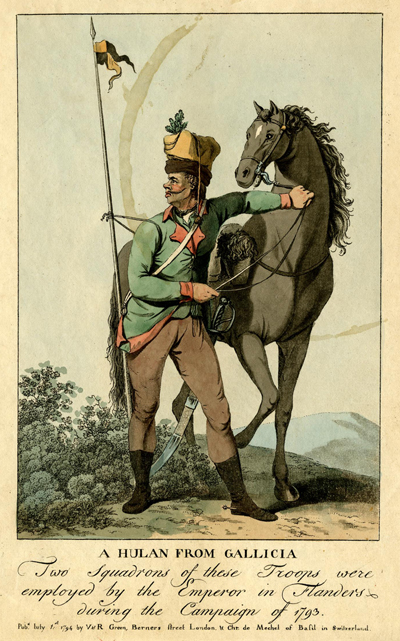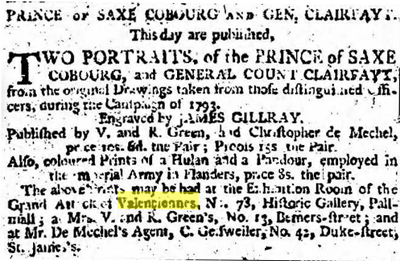A Hulan from Gallicia*
According to Wikipedia, the orginal Ulans were Polish-Lithuanian cavalry units, armed with a lance, a sabre, and a pistol. Their lances typically had small swallow tail flags just below the spearhead and their headdress was based on the square topped Polish lancer helmet. As the use of heavy cavalry declined in 18th century warfare, the Ulans became the model for light cavalry units throughout Europe.
The Hulan in this print conforms, in most points, to the general Polish model, but he comes from Gallicia (Galicia), a region in Northern Spain. (Along with England and Austria, Spain was, after all, a part of the First Coalition against revolutionary France.) As the print suggests, two squadrons of these Spanish Hulans were used by the Austrian troops in the Flanders campaign and more specifically at the grand victory at Valenciennes led by King George's second son, the Duke of York.

© Trustees of the British Museum
Gillray had been commissioned by print publishers Valentine and Rupert Green and Christian von Mechel to assist in the research for a large scale painting by Philip James de Loutherbourg celebrating that victory. Gillray was to make preparatory sketches of the principal officers and the cannons, uniforms, pack horses, and other military equipment that would likely appear in a painting of the battle while de Louthbourg sketched the battle landscape and surrounding countryside. On September 5th, 1793 Gillray made a sketch of the Austrian Prince of Saxe-Coburg at his camp at Bermerain. While he was there, he likely made sketches of the more coloful of the Prince's troops, including a Hulan from Gallicia and a Pandour from Croatia.
On June 3, 1784, the London St. James's Chronicle announced that the finished de Loutherbourg painting was being displayed "on the Ground Floor, at the Historic Gallery, Pall-Mall. Admittance, One Shilling." Patrons of the exhibition could then subscribe to receive a planned print reproduction of the painting. But it couldn't have been too much later that the publishers/promoters of this scheme, Valentine and Rupert Green and Christian von Mechel, realized that they could get additional revenue at the Exhibition by selling some smaller prints related to the Grand Attack. Those included portraits of the foreign leaders of the combined Coalition forces, the Prince of Saxe-Coburg and General Count Clairfayt, and (in smaller print) "coloured Prints of a Hulan and a Pandour."

London Times
[July 16, 1794]
Among the many drawings created by Gillray to assist de Loutherbourg, there is a sketch of the Pandour from Croatia in the British Museum collection, so we can see how seriously Gillray took his job of documenting the troops and their equipment. See my commentary on A Pandour from Croatia. But we can safely assume that his approach to the Hulan from Gallicia would have been similar.
* Many thanks to Tim Clayton for alerting me to the existence of this print and its companion, A Pandour from Croatia
Sources and Reading
- Commentary from the British Museum on A Hulan from Gallicia.
- "Uhlan," Wikipedia
- "War of the First Coalition," Wikipedia
Comments & Corrections
NOTE: Comments and/or corrections are always appreciated. To make that easier, I have included a form below that you can use. I promise never to share any of the info provided without your express permission.